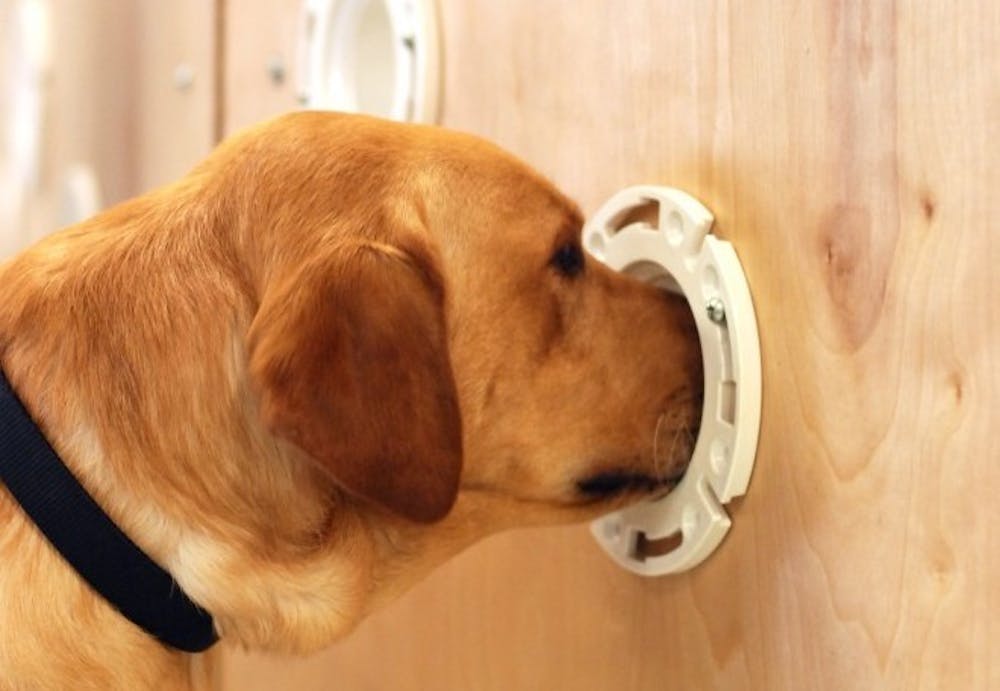For years, dogs have worked with law enforcement officials to track down a variety of illicit substances. Now, experts at Penn believe that dogs might also be capable of sniffing out another type of contraband: stolen ancient artifacts.
The Penn Vet Working Dog Center and the Penn Museum are collaborating with Red Arch Cultural Heritage Law and Policy Research, a nonprofit dedicated to protecting cultural property, to host a program called K-9 Artifact Finders.
Given that the annual value of ancient artifacts looted, stolen, and/or smuggled comes up to between $4.5 billion to $6 billion per year, the theft of cultural property has been a growing concern for the U.S. Department of Homeland Security.

Photo from John Donges
“[K-9 Artifact Finders is] an innovative way to disrupt the market in illicit antiquities, and that’s really what needs to happen to slow down the pace of looting and theft in conflict zones,” consulting scholar for the Penn Museum and 2000 Penn doctoral graduate Michael Danti said. “Currently, art crime, that means fine arts, antiques, antiquities, is usually ranked as the fourth or fifth largest grossing dollar criminal activity in the world on an annual basis.”
Danti said terrorist organizations often use stolen cultural artifacts to fund their operations, deliberately destroying them and using them for propaganda and “click-bait.” He added that high-profile groups like the Islamic State have continuously done this, setting a precedent for other similar organizations to employ the same techniques.
According to the WDC director and Penn Vet professor Cynthia Otto, the WDC will begin training four dogs this month. She added that these dogs were selected based on “their availability and their odor detection skills.”
According to the Red Arch website, the K-9 Artifact Finders program will occur in three stages. Phase one will entail training the dogs at WDC using archaeological artifacts from the Penn Museum. If successful, phase two will be “on-the-ground” testing, while phase three would be training the dogs to work alongside customs officers to detect stolen cultural property.
RELATED:
Penn's police dog Socks and her litter of four puppies report for duty
Penn Vet will receive $30 million in state funding after all
Otto said there is a special procedure to introduce the smell of artifacts to dogs without compromising the artifacts.
“Our main training approach will be to use cotton balls and let the artifacts and cotton sit together in a closed non-permeable bag. That way the odor from the artifacts is absorbed by the cotton and we don’t have to risk damage to the artifacts,” Otto said. “We will also train the dogs to ignore the odor of the plain cotton and other things that might be similar but not the actual artifact.”
The artifacts will mainly be selected from regions in Iraq and Syria, which Danti claims are the “hotspots” for cultural heritage looters.
Danti also said they are aiming to find scents that apply to a “wide range of antiquities." However, it will be difficult to ensure that the smell of the artifacts are not similar to common odors, he added.
Danti said the aim of the program is to make the implementation of this program as easy as possible for Homeland Security and other border protection agencies and personnel.
“We first want to know, can it be done?” Red Arch Executive Director Ricardo St. Hilaire said to the Penn Current. “Secondly, if it can be done, we’d like to offer a demonstration or a methodology that, for instance, U.S. Customs and Border Patrol officials can use to train their own dogs.”



